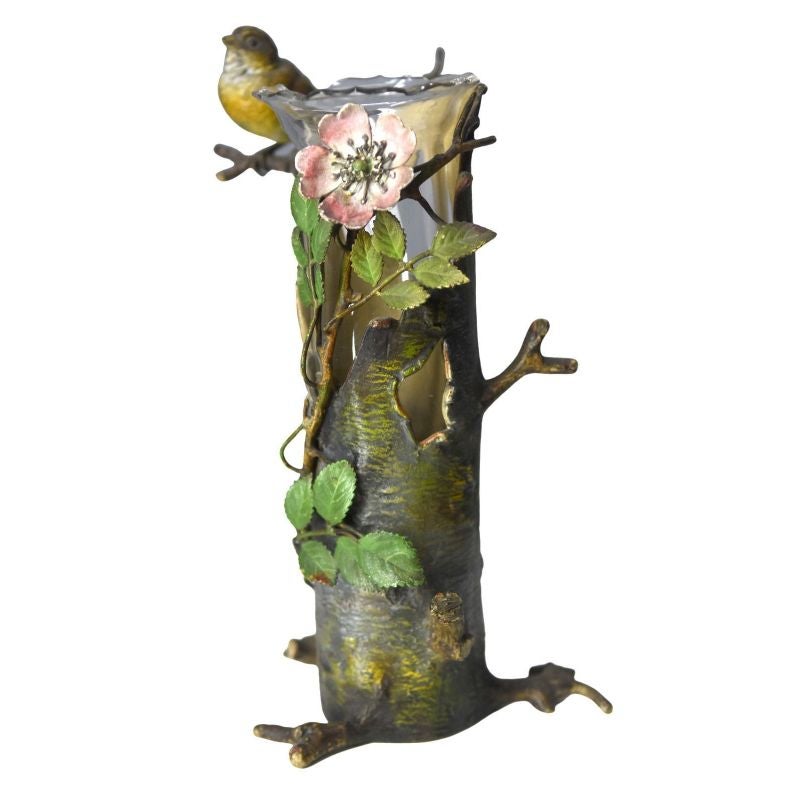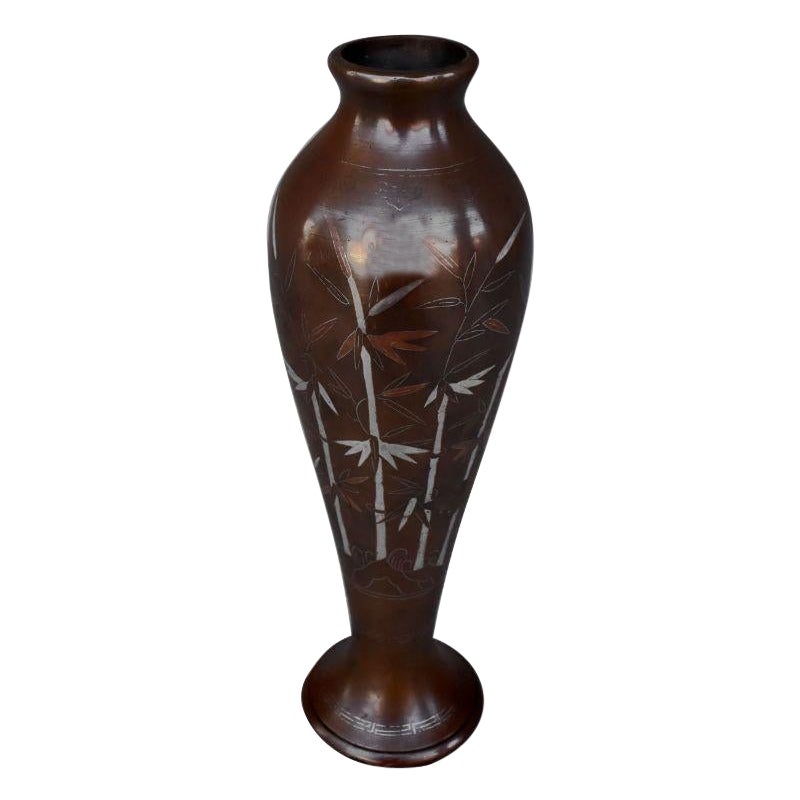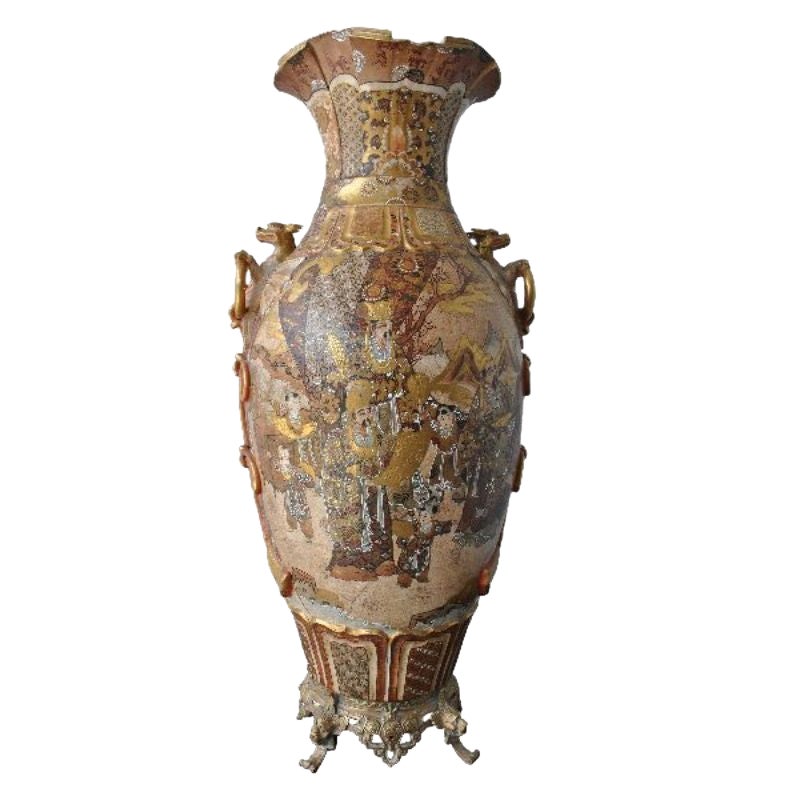Items Similar to Pair of Gilded Bronze Vases, XIXth Century
Want more images or videos?
Request additional images or videos from the seller
1 of 9
Pair of Gilded Bronze Vases, XIXth Century
About the Item
Pair of Medici vases in gilded and chiseled bronze with plinth base decorated with vegetable and Greek motifs. The two vases have two terminal handles with lion heads.
- Dimensions:Height: 11.42 in (29 cm)Width: 4.34 in (11 cm)Depth: 4.34 in (11 cm)
- Sold As:Set of 2
- Style:Other (Of the Period)
- Materials and Techniques:
- Place of Origin:
- Period:
- Date of Manufacture:1800s
- Condition:Wear consistent with age and use.
- Seller Location:Milano, IT
- Reference Number:1stDibs: LU1721226904262
About the Seller
4.9
Gold Seller
These expertly vetted sellers are highly rated and consistently exceed customer expectations.
Established in 2015
1stDibs seller since 2015
358 sales on 1stDibs
Typical response time: 1 hour
- ShippingRetrieving quote...Ships From: Milan, Italy
- Return PolicyA return for this item may be initiated within 10 days of delivery.
More From This SellerView All
- Pair of Sèvres Porcelain Vases, XXth CenturyBy Manufacture Nationale de SèvresLocated in Milano, ITPair of Sèvres porcelain vases with amorous scenes painted in polychrome inside reserves and signed by Granet. On a cobalt blue background the rich gold decorations with leafy scroll...Category
20th Century French Other Vases
MaterialsBronze
- Pair of Porcelain Vases Old Paris - France 1830-1860By Non-Standard Furniture and LightingLocated in Milano, ITPair of porcelain vases in the manner of Jacob Petit decorated with scenes of everyday life and bouquets of flowers in the reserves. Rich highlights in pure gold.Category
Antique 19th Century French Other Vases
MaterialsPorcelain
- Sèvres Porcelain Vase, France, XIX CenturyLocated in Milano, ITSèvres porcelain urn vase in cobalt blue with gilded phytomorphic decorations and polychrome medallions, in one depicting a lake landscape, while in the other a bucolic scene; in the latter, he signs “Cottiret”. The polylobed base, the handles with female heads and the pine cone of the lid are in gilded bronze. Under the lid there is written “Offert par le duc de Choiseul...Category
Antique 19th Century French Other Urns
MaterialsPorcelain
- Baluster Vase Porcelain China xx CenturyLocated in Milano, ITBaluster porcelain vase with Fô dog shape lid, decorated in polychrome enamels with flowers and butterflies and within polylobed cartouches with scenes of court...Category
20th Century Chinese Other Vases
MaterialsPorcelain
- Moser Bohemia Crystal Vase Tschecoslovakia XX CenturyLocated in Milano, ITVase in transparent, red and opal crystal with gold decorations and polychrome plant motifs in the central band.Category
20th Century German Other Vases
MaterialsCrystal
- Ceramic Vase, France, 1920sLocated in Milano, ITCeramic vase with full-field decorations with plant and animal motifs. Under the base brand of the manufacturer.Category
Vintage 1920s French Other Vases
MaterialsCeramic
You May Also Like
- Vase Mounted by a Viennese Bronze Bird, XIXth CenturyLocated in Marseille, FRGlass vase mounted by a Vienna bronze representing a bird perched on a branch. XIXth century work. Dimensions height 22 cm. Unfortunately part of the glass rim is broken. Addition...Category
Antique 19th Century Vases
MaterialsBronze
- Old Bronze Soliflore Vase Japan, XIXthLocated in Marseille, FROld bronze soliflore vase decorated with foliage from Japan, late 19th century, height 24 cm. Additional information: Material: Bronze Dimension: 8...Category
Antique 19th Century Vases
MaterialsBronze
- Pair of Porcelain Vases with Gilded DetailLocated in Newport Beach, CAA beautiful pair of porcelain vases with a hand painted and gilded glazed overlay.Category
Antique 19th Century European Other Vases
MaterialsPorcelain
- Japanese Satsuma Vase, XIXth CenturyLocated in Marseille, FRLarge Japanese vase in Satsuma, 19th century, height 88 cm. For a diameter of 36 cm. Usual restoration. Additional information: Material: Earth...Category
Antique 19th Century Japanese Vases
MaterialsEarthenware
- PAIR OF ANTIQUE FRNECH GILDED BRONZE EWER VASES, 19th CENTURYLocated in Rostock, MVA very rare pair of antique French neo-classical gilded bronze ewer vases from the 19th century. These ewers, created in the mid-19th century, are wonderful examples of the revival ...Category
Antique 19th Century French Neoclassical Vases
MaterialsBronze
- Pair of Porcelain Vases Ormolu-Mounted in Lamps by Gagneau Paris XIXth CenturyBy Gagneau ParisLocated in Saint-Ouen, FRPair of large Japanese Porcelain Cone Shape Vases with Imari decoration Important mounts in ormolu and gilded metal, the base decorated with a laurel wreath, the upper part of falling leaves and a frieze of knotted ribbon. The mounts signed Gagneau, 115 R. Lafayette. Circa 1860 With their original aluminium bulb cover and original gilding Vase it self Height 47 cm The Gagneau Company is one of the most famous lighting factories in Paris in the nine-teenth century, established in 1800 at 25 rue d'Enghien in Paris and later at 115 rue de Lafayette. She has participated in many exhibitions throughout this century. She began in 1819 with the Exposition des Produits de l'Industrie and later participated in the Universal Exhibitions where she was part of the jury in the category of art bronzes (class 25) at the Universal Exhibition in Paris in 1889. "Imari" was simply the trans-shipment port for Arita wares, from where they went to the for-eign trading outposts at Nagasaki. It was the kilns at Arita which formed the heart of the Japanese porcelain industry. Arita's kilns were set up in the 17th century, after kaolin was discovered in 1616. A popular legend attributes the discovery to an immigrant Korean potter, Yi Sam-Pyeong (1579–1655), although most historians consider this doubtful. After the discovery, some kilns began to produce revised Korean-style blue and white porcelains, known as Early Imari, or "Shoki-Imari". In the mid-17th century, there were also many Chinese refugees in northern Kyushu due to the turmoil in China, and it is said that one of them brought the overglaze enamel coloring technique to Arita. Thus Shoki-Imari developed into Ko-Kutani, Imari, and later Kakiemon, which are sometimes taken as a wider group of Imari wares. Ko-Kutani was produced around 1650 for both export and domestic market.Kutani Ware is characterized by vivid green, blue, purple, yellow and red colors in bold designs of landscapes and nature. Blue and white porcelain pieces continued to be produced and they are called Ai-Kutani. Ko-Kutani Imari for the export market usually adopted Chinese design structure such as kraak style, whereas Ai-Kutani for the domestic market were highly unique in design and are ac-cordingly valued very much among collectors. Ko-Kutani style evolved into Kakiemon-style Imari, which was produced for about 50 years around 1700. Kakiemon was characterized by crisp lines, and bright blue, red and green designs of dramatically stylized floral and bird scenes. Imari achieved its technical and aes-thetic peak in the Kakiemon style, and it dominated the European market. Blue and white Kakiemon is called Ai-Kakiemon. The Kakiemon style transformed into Kinrande in the 18th century, using underglaze blue and overglaze red and gold enamels, and later additional colors. Imari began to be exported to Europe when the Chinese kilns at Jingdezhen were damaged in the political chaos and the new Qing dynasty government halted trade in 1656–1684. Ex-ports to Europe were made through the Dutch East India Company, and in Europe the des-ignation "Imari porcelain" connotes Arita wares of mostly Kinrande Imari. Export of Imari to Europe stopped in mid-18th century when China resumed export to Europe, since Imari was not able to compete against Chinese products due to high labor costs. By that time, however, both Imari and Kakiemon styles were already so popular among Eu-ropeans that the Chinese export porcelain copied both, a type known as Chinese Imari. At the same time, European kilns, such as Meissen and English potteries such as Johnson Bros. and (Royal) Crown Derby, also imitated the Imari and Kakiemon styles. Export of Imari surged again in late 19th century (Meiji era) when Japonism flourished in Europe.Thus, in the western world today, two kinds of true Japanese Imari can...Category
Antique 1880s French Japonisme Table Lamps
MaterialsBronze
Recently Viewed
View AllMore Ways To Browse
Gilded Pair
Greek Motif
Plinth Vase
Gilded Lion
Gilded Bronze Bedroom
Pair Gold Vase With Handles
Gold Head Vase
Two Headed Vase
Gilded Bronze Vase
19th Century Greek Vessel
Italian Gilt Vase
Pair Of Lion Vases
Lions Head Vases
Pair Of Greek Vases
Lion Head Bedroom Furniture
Vase With Lion Head
Medici Pair
Vases Medicis





